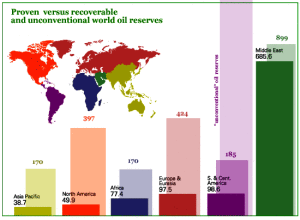By Bill Kovarik, PhD
(First published in 2002). 
- Middle Eastern oil in perspective
- Comparison of USGS and oil industry reserve estimates
- Unconventional oil reserves
- World media has one view of oil reserves
- World oil reserve figures vary considerably in history
- Conclusion and References
Comparison of USGS and oil industry conventional reserve estimates (billions of barrels)
| DOE / OGJ (1) | DOE/ GULF(2) | USGS (3) | USGS (4) | |
|
Proven reserves
(oil industry) |
Identified |
Recoverable reserves |
||
|
Iran
|
89.7 | 93.1 |
69.2
|
128.9
|
|
Iran % world
|
8.8
|
9.5
|
6.3
|
5.7
|
|
Iraq
|
112.5 | 100.0 |
90.8
|
147.8
|
|
Iraq % world
|
11.1
|
10.2
|
8.2
|
6.5
|
|
Kuwait
|
96.5 | 94.7 |
85.7
|
112.3
|
|
Kuwait Neutral Zone
|
NA | NA |
13.7
|
20.6
|
|
Total Kuwait % of world
|
9.5%
|
9.65%
|
9.01
|
5.84
|
|
Oman
|
5.3 | 5.7 |
7.5
|
12.3
|
|
Qatar
|
3.7 | 5.4 |
3.9
|
8.7
|
|
Saudi Arabia
|
263.5 | 261.4 |
258.6
|
374.2
|
|
Saudi % world
|
25.9
|
26.6
|
23.4
|
16.5
|
|
Syria
|
2.5 | 2.3 |
3.9
|
5.7
|
|
United Arab Emirates
|
97.8 | 63.8 |
61.1
|
79.7
|
|
Yemen
|
4.0 | 2.1 | ||
|
Other
|
0.0 | 0.5 |
2.70
|
3.7
|
|
Total Mid East
|
675.6 | 629.2 |
597.2
|
899.2
|
|
All Mid East. as % world
|
66.4
|
64.1
|
54.1
|
39.6
|
|
North America
|
55.1
|
55.6
|
112.1
|
397.9
|
|
South America
|
89.5
|
69.2
|
77.6
|
185.5
|
|
Europe & former USSR
|
77.6
|
82.3
|
166.2
|
423.8
|
|
Europe & Frmr USSR as % world
|
7.6
|
8.3
|
15.0
|
18.6
|
|
Africa
|
74.9
|
86.5
|
76.5
|
170.7
|
|
Asia
|
44.0
|
58.7
|
71.2
|
170.6
|
|
Total
world estimate |
1016.8
|
981.4
|
1103.2
|
2272.5
|
This chart prepared by Bill Kovarik, Ph.D., formerly editor of publications such as Energy Resources and Technology and Latin American Energy Report.
This chart compares oil industry and the US Department of Energy statements about “proven” reserve estimates (two yellow columns) with US Geological Survey estimates of identified reserves (first blue column) and USGS ultimately recoverable reserves (second blue column).
Points to observe in this table:
• The US Department of Energy (yellow columns) uses private oil industry statistics, and not reserve figures from another (and presumably more trustworthy) government office, the USGS (blue columns).
• Does the Middle East have two thirds of the world’s oil reserves? Notice the USGS figures stating that it has (respectively) 54 and 39 percent — NOT two thirds.
• Does Iraq have the world’s second largest oil reserves? Not if you include the Kuwait Neutral Zone as part of Kuwait rather than Iraq, according to USGS.
• Does the USGS have a different view of the potential of Europe, Russia and the former USSR than the oil industry?
SOURCES
World Crude Oil and Natural Gas Reserves, US Department of Energy, Energy Information Administration. (Links to updated 2007-2009 site) These oil reserve estimates have recently been given with additional footnotes explaining, for example, that one half of the Kuwait Neutral Zone reserves are now assigned to Kuwait. (Why only one half is not stated). Very recently a disclaimer was added by the Energy Information Administration, which now says it “does not attempt to develop estimates for foreign countries. As a convenience to the public, EIA makes available foreign fuel reserve estimates from other sources, but it does not certify these data..”
EIA sources for world oil reserve estimates in the table above are from the following oil industry trade publication estimates:
(1) PennWell Publishing Co.,Oil and Gas Journal, Vol 97, No. 51, December 1999.
(2) Gulf Publishing Co., World Oil, Vol 221, No. 8, August 2000
Note that the Department of Energy does not use USGS government statistics. When asked why, DOE did not comment and USGS said it was “not a political agency.”
(3 and 4) USGS World Petroleum Assessment and Analysis (2000 figures — Updates are available at this site).
